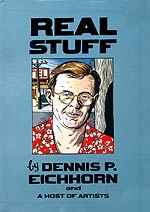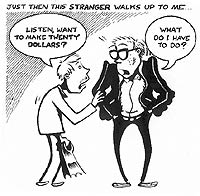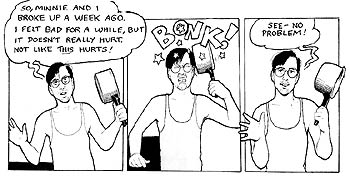
|
Dennis P. Eichhorn's "Real Stuff" (Swifty Morales Press; 208 pp.; $19.95) collects highlights from the mid-'90s series of the same name. Part of an autobio boomlette of the time, Eichhorn's stories stood out for their juicy barroom-vignette style. Full of violence, sex and drugs, nearly all of them could begin, "I remember one time " Put into rough chronological order, starting from his childhood, the collection slowly adds up to a portrait of a rebellious baby boomer — from angry gridiron jock to drugged-out longhair, and into mellowed middle age.
The first story recounts young Eichhorn's discovery of "Mad" magazine, an event that so altered his childhood consciousness that he was compelled to vomit. Eichhorn's life-long anti-authoritarianism seems to emerge from the experience. The book moves on to tales of Eichhorn's days as a high school and college football player. These include accounts of Eichhorn's witnessing a jailbreak while scrimmaging with a prison team, kicking out the eyeball of a menacing townie, and participating in group sex with a few dozen freshmen and a nurse named Rosie.
 Peter Bagge illustrates a typical Eichhorn tale: a guy holding a pair of flippers walks up and says...
Peter Bagge illustrates a typical Eichhorn tale: a guy holding a pair of flippers walks up and says... |
In the mid-sixties Eichhorn discovers LSD and begins a period of odd jobs and wandering around. One remarkable story tells of a college trip to a mental home while tripping on acid. Each of the patients is brought out like a freak show, ending with the man who wouldn't talk. Asked a simple question by Eichhorn, he speaks right up, denouncing the institution. After reading for a while, though it becomes clear that the tales of crazy women, bar fights and pot smoking are a way to avoid any more meaningful revelations. For example, Eichhorn's adoption, getting kicked out of school and two failed marriages are only hinted at. Instead, one enjoys the outrageous vignettes for their superficial entertainment value — a not-so-terrible pleasure. It's like buying the old barfly drinks to see what he'll come out with next.
Part of what makes these highly entertaining stories so readable is their presentation in comix form. Eichhorn, who doesn't draw, was smart enough to hire the best cartooning talent at a time when alty comix were beginning to really blossom. Consequently, the artists read like a who's who of top cartoonists, including Charles Burns, Chester Brown, Dan Clowes, Joe Sacco, Jason Lutes, Julie Doucet and tens of others. The best pieces match the cartoonist with the material. Carol Moiseiwitsch's splattery black and white imagery lends a horrifying intensity to "Fatal Fellatio." Peter Bagge, of "Hate" fame, punches up several tales, including one about a flipper fetishist, with his loopy graphics.

|
"David Chelsea in Love," by David Chelsea (Reed Press; 192 pp.; $16.95) also includes plenty of sex, but the only violence is of the mind. Finally back in print after first appearing in 1993, the book chronicles Chelsea's relationship during his early twenties with "Minnie," a gawky-looking but charismatic would-be actress with deep insecurities and a hopeless commitment phobia. The character's various pairings in the pre-HIV world of the early '80s read like a soft-core black comedy.
The story begins when David, a native of Portland, Oregon, moves to New York in an effort to become a professional illustrator. During one of his trips home he meets Minnie, a tall gal with lots of personality who currently has a boyfriend, but doesn't let that stop her from being wooed by the dorky but charming Chelsea. Nor does David resist sleeping with Paprika, one of his housemates. Their post-coital repartee sums up the attitude of everyone in the book, a peculiar mix of promiscuity and devotion. Chelsea: "So, uh, you're not like really in love with me or anything are you because I think I'm really in love with someone else." Paprika: "You think I give a shit?"
 David Chelsea copes with his most recent breakup with Minnie
David Chelsea copes with his most recent breakup with Minnie |
The sexy schadenfreude really begins when David returns to New York and tries to get Minnie to join him. After teasing him along for a few months she finally arrives, but moves out within days because she decides she doesn't love him. The remainder of the book is a detailed portrait of a hopeless emotional dynamic between a needy doormat, a manipulative neurotic and the various ancillary lovers that get involved with them. "David Chelsea in Love" reads like a comical horror show, compelling you to keep turning pages while sucking wind through your teeth at each new development. Even if the story gets a little exasperating (Dump her already!) you can at least count on a good sex scene very ten pages or so.
Those sex scenes get punched up by being rendered in a near-photorealistic, pointillist style. They contrast sharply with the cartoonier look of the rest of the book. It's like the only reality for these people is when they are in bed together. The parts of the book that carry the story slyly reference the style of Winsor McCay, a pioneering cartoonist whose most famous strip was called "Little Nemo in Slumberland." Like McCay, Chelsea plays with the comix form by busting up the layouts and adding whimsical, surreal moments. At one point David's reflection steps out of the mirror, dressed in a clown suit, and tries to talk some sense into the freshly humiliated artist.
Sexy, funny and extremely compelling, both "David Chelsea in Love" and "Real Stuff" are top examples of the comix autobiographic form. They prove that even the seemingly unextraordinary life has as much drama as that of anyone considered more worthy of public exposure.
